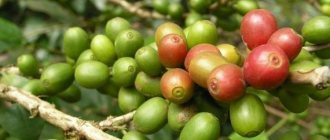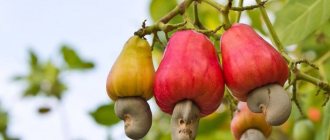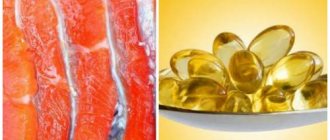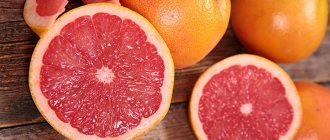Chestnut is found everywhere in Russia. It's called Horse Chestnut. The fruits of this plant are poisonous. They are not suitable for human consumption. If you want to enjoy the amazing taste of interesting dishes, then you need to use edible fruits. Visually they resemble hazelnuts, but contain more proteins and carbohydrates. The nut is high in calories. In order not to gain extra pounds, it is better to eat nuts in small portions, following the recommended daily dosage.
Nutritional value and calorie content of chestnut
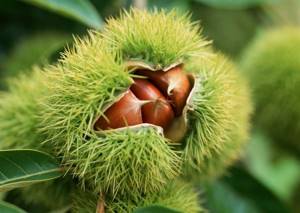
Chestnut is a valuable product in nutrition because it has a high energy value and a rich chemical composition, which, in combination with other products, can meet the physiological needs of humans.
KBJU chestnuts:
| Chestnut fruits (type of processing) | Kcal per 100 g | Proteins (g) | Fat (g) | Carbohydrates (g) |
| Raw fruits | 166 | 2,31 | 0.54 g | 34,92 |
| Fried | 245,6 | 3,22 | 2,21 | 53,4 |
| Boiled | 131,9 | 2,05 | 1,43 | 27,82 |
Nuts contain about 6% protein, 60% starch, 15% sugars, and more than 2% fat.
Vitamin and mineral composition
The vitamin and mineral composition of the plant includes the following organic compounds:
Vitamins:
| Name | Quantity | Beneficial features |
| A | 1.0 mcg | Fat-soluble vitamin, its content in chestnut is negligible |
| B1 | 0.1 mg | Participant in lipid and protein metabolism, supports heart, digestive and nervous system functions |
| B3 (PP) | 1.1 mg | Affects redox processes |
| B5 (pantothenic acid) | 0.5 mg | Participates in metabolism, fatty acid synthesis |
| B6 | 0.4 mg | Catalyst for the production of amino acids and neurotransmitters in the body |
| B9 (folic acid) | 58.0 mg | The substance is necessary for hematopoiesis and immunity |
| C (ascorbic acid) | 40.2 mg | Supports bone and connective tissue, eliminates toxins, has immunomodulatory properties |
Minerals:
| Name | Quantity | Beneficial features |
| Calcium | 19 mg | Strengthens the structure of bones, teeth and hair |
| Magnesium | 30 mg | Supplies energy to cells, participates in the synthesis of enzymes. Positively affects the central nervous system and the functioning of the heart muscle |
| Iron | 0.9 mg | Is a catalyst for oxygen exchange |
| Phosphorus | 38 mg | Supports bone structure |
| Sodium | 2 mg | Normalizes acid-base balance |
| Potassium | 484 mg | Maintains the balance of electrolytes, creates conditions for muscle contractions, having a beneficial effect on heart rhythm. Strengthens cell membranes, maintains the balance of substances dissolved in the blood |
| Manganese | 0.3 mg | Affects growth, gonadal function and hematopoiesis |
| Zinc | 0.5 mg | Affects male sexual function, participates in metabolism, production of vitamin E and anabolic hormones |
| Copper | 0.4 mg | Activates the work of enzyme systems |
Be sure to read: What are the benefits of pine nuts: calorie content, effective use
Storage period and conditions
Fresh chestnuts do not withstand long-term storage. In vacuum packaging or a hermetically sealed jar at a low temperature, they retain beneficial properties for no longer than two weeks. Then gradually the shell of the fruit bursts, and valuable qualities are lost.
In the freezer, unpeeled fresh chestnuts remain healthy for six months. The shelf life of boiled or fried kernels increases to a year.
Delicious and nutritious, chestnuts benefit men, women and children when consumed in moderation. Edible fruits are mainly used in cooking. The horse counterpart is more successful in healing.
How to eat chestnuts: use in cooking
Noble chestnut can be eaten raw, but in this case the taste will not impress, so various dishes are prepared from the fruit.
The simplest and most common cooking method is frying in a pan for 15 minutes, and the product is best consumed warm.
The fruits are boiled and baked, smoked, combined with butter and even cognac, ground into flour, and steamed to increase dietary properties.
Chestnut nuts are widely used in cooking, the fruits are included in desserts, side dishes and salads, and individual dishes are prepared:
- cream soups;
- sauces;
- Pieces of fruit are stuffed into the bird.
In southern Europe, where chestnuts are popular, the nuts are preserved, soaked in wine, pickled, and coffee substitutes are made from the dry powder. A paste is prepared from the pulp; the sweet delicacy is eaten spread on bread.
Important! It is necessary to distinguish between horse chestnut (horse chestnut) and edible one. In the first case, the seeds of the plant are unsuitable for food, and it is easy to get poisoned if they are consumed.
What types are edible?
Due to their rich composition, chestnut nuts are widely recommended for consumption. However, not all fruits are safe for the body. Which chestnuts are edible:
- Chinese;
- European sowing;
- crenate, or Japanese.
The fruit can be picked from the tree when the nuts are dark brown in color. The following are suitable for consumption:
- smooth;
- heavy;
- hard;
- smooth.
Horse chestnut fruits should not be consumed. It is recommended to prepare nuts according to the following recipe:
- Make several cuts on the fruit.
- Place in a frying pan that is hot enough.
- Cover with wet wipes or towel.
- Fry in a sealed container for 20 minutes.
- The napkins must be constantly moistened until the shell begins to crack.
You can tell when chestnuts are ready by their dark color. The shell of the fruit should crack and the pulp will become visible. Without waiting for them to cool, they should be cleaned immediately. They are consumed hot, with a small amount of vegetable oil and salt.
Benefits of chestnut for the body
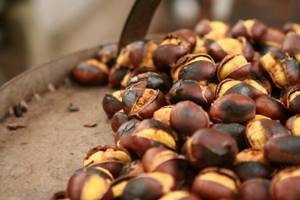
The unique chemical composition makes chestnut a healthy product.
Thanks to the consumption of nuts:
- the walls of blood vessels are strengthened;
- blood flow is activated by reducing blood clotting, expanding the lumen of veins and capillaries;
- brain functions improve;
- blood pressure decreases;
- stimulates the synthesis of enzymes, improving metabolism;
- muscle tone increases;
- swelling goes away.
Chestnut promotes quick saturation and gives energy to the body. The fruits can be consumed to restore strength after physical and mental stress.
The vegetable protein contained in nuts increases the value of the product for people following a vegetarian diet. They are recommended for use in nutrition to maintain protein balance.
Benefits for adult men and women
Moderate consumption of the fruits of the chestnut tree helps adults fight certain diseases.
What are the benefits of chestnut:
| For women | For men |
| Elimination of congestion in the pelvic area, normalization of the reproductive organs | Stimulating blood circulation helps restore potency |
| During menstruation – improved well-being, pain relief | Activation of blood flow. Flavonoids help reduce inflammation in prostatitis |
| Relief during menopause | Prevention of the formation of a malignant process in the prostate gland |
| Prevention of the development of mastopathy and cancer of the genital organs | Prevention of hemorrhoids |
Important! When consumed correctly, chestnut fruits prevent the formation of varicose veins.
Chestnut during pregnancy
A complex of elements and vitamins, the ability to provide energy and improve mood - these properties of chestnut make it a valuable product for pregnant women. Therefore, during the period of bearing a child, you are allowed to enjoy delicious fruits.
Be sure to read: Hazelnuts: beneficial properties, calorie content per 100 grams
But don’t get too carried away, as carbohydrates can cause excess weight gain, heavy food can cause bloating, and the effect on vascular tone can cause complications.
If the expectant mother is concerned about pressure surges, disturbances in the digestive tract, constipation, allergies, she should stop eating nuts.
Beneficial features
The medicinal properties of chestnut improve human well-being and have a beneficial effect on health. The use of nuts in folk medicine is associated with the treatment of:
- liver diseases;
- varicose veins;
- hemorrhoids;
- thrombophlebitis;
- rheumatism;
- atherosclerosis;
- hypertension;
- diseases of the heart and blood vessels.
The nut has the following effects on the body:
- vascular strengthening;
- wound healing;
- astringent;
- anti-inflammatory;
- decongestant.
For children
Pediatricians recommend not allowing children to eat chestnuts before the age of 5. Otherwise, an unbearable load will be placed on the digestive system, which is manifested by bloating and constipation.
Boiled nuts are the healthiest for children's bodies. It is also added to soup and mashed potatoes.
During pregnancy and lactation
Eating chestnuts during pregnancy is allowed, but in each case you should consult your doctor. The products will help eliminate mood swings and protect against the negative effects of stress and depressive disorders.
This is especially necessary during pregnancy. Eating fruits can improve digestion and normalize blood pressure.
Nuts also benefit breastfeeding women. They enhance milk production. Vitamins and mineral components help improve the quality of breast tissue.
Application in medicine
Horse chestnut is used in pharmacology; medicines based on it are indicated in the treatment of venous circulation disorders and bruises. Preparations containing plant extract include Aescusan, Esculus, Venitan, Reparil.

Aescusan
In folk medicine, the anti-inflammatory, tonic, regenerating and astringent properties of noble chestnut and acorn are used more widely. The raw materials for preparing the medicine are all parts of the plant - leaves, bark, fruits, inflorescences and buds.
Decoctions, tinctures, and ointments are prepared from them, which help alleviate the condition of the following diseases:
- arthritis and osteochondrosis;
- varicose veins and thrombophlebitis;
- bronchitis;
- haemorrhoids;
- atherosclerosis;
- gynecological pathologies;
- disturbances in liver function;
- bleeding.
Chestnut honey is especially valued; the product is recommended to be consumed in a teaspoon for gastrointestinal diseases, endocrine disorders, vascular and heart pathologies, and anxiety conditions.
Sweet medicine helps with kidney disease, colds and low immunity.
Types of chestnuts
Several types of noble chestnut are known in nature:
- Japanese crenate;
- European sowing;
- Chinese.
Chestnuts growing in Europe are the largest and most powerful. Some representatives live up to 1000 years. The yield of each tree reaches 200 kg. Famous European varieties are Neapolitan, Large-fruited, Buryu de Lillyak, Lyon. Fruits of all types have a pleasant sweet taste.
The Japanese have developed more than 100 varieties of their own edible chestnut. The trees are no higher than 15 meters tall and produce fruits weighing 80 grams. They are frost-resistant and perfectly resistant to pest attacks.
Chinese chestnut trees, growing in Vietnam, Korea, and southern Russia, are also small in stature. But it is their fruits that are considered a delicacy. Used in oriental cuisine due to its excellent taste.
The use of chestnut in cosmetology
The fruits, bark and leaves of chestnut are used in cosmetology. Extracts of all parts of the plant are included in creams, shampoos and hair balms, and nail care products.
Moisturizing and rejuvenating masks are prepared from crushed inflorescences by adding cucumber, cottage cheese, honey or egg.
Chestnut oil is made from nuts and when applied to the skin it has the following effects:
- softens and eliminates peeling;
- reduces inflammation;
- improves blood circulation and tones;
- relieves swelling;
- smoothes out wrinkles.
The oil is recommended for normal to dry skin and is well tolerated in cases of hypersensitivity.
Be sure to read: How many calories are in peanuts, benefits and harm to the body
For oily skin with enlarged pores, prepare a lotion by mixing 100 ml of leaf decoction and a small spoon of vodka. The face is treated with the composition every day. After a week, the oily sheen will disappear and your facial skin will become smooth.
How to choose chestnuts
It is better to purchase nuts during the harvest season, when they are maximally saturated with natural ingredients that benefit the body. Chestnuts ripen from September to November. When purchasing, focus on the criteria for choosing a quality product:
- glossy brown color of a smooth shell without spots;
- sensation of core weight;
- same fruit size.
When purchasing chestnuts in a store, pay attention to the release date and expiration date indicated on the label. Attention! When buying a product at the market, make sure that it is an edible chestnut. Horse fruits are also sold.
Chestnuts for weight loss
Chestnut fruits are not used for weight loss. Due to the large amount of carbohydrates, the dish is not included in the diet menu.
During the period of weight loss, eating nuts can be justified, since the product is a source of energy, contains little fat, and even a small amount gives a feeling of fullness.
But when consuming, it is important to take into account the amount of calories so as not to exceed the daily norm, so it is preferable to eat boiled fruits.
Attention! Chestnuts are often confused with Brazil guarana nuts, which are sold in powder form; visually, both products are very similar. The tropical plant contains oil esters, flavonoids, bioactive components and large amounts of caffeine. Used to burn fat by increasing body tone.
Fresh chestnut
The fruits contain a large amount of vitamins, minerals and other nutrients. Edible chestnuts are not usually consumed fresh. They are typically baked, fried, or made into confectionery additives or flour.
The calorie content of chestnuts is 166 kcal. The nutritional value of the product is as follows:
- 3.4 grams of protein;
- 30.6 grams carbohydrates;
- 3.0 grams fat.
Nuts make not only tasty and healthy dishes, but also a large number of different folk recipes that have a healing effect. Most often, chestnut is used as the main component in hemostatic drugs. Unripe fruits contain a lot of vitamin C. It has a beneficial effect on the human body. Therefore, in folk recipes, the edible nut is found in different forms. Other parts of the tree can also be used. Among them:
- kidneys;
- leaves;
- bark;
- wood.
Chestnut has long been used as food in a variety of dishes. It has a large number of unique properties that are important for the positive functioning of the human body. Today the product is found in the following forms:
- candied;
- fried;
- boiled;
- cheese;
- processed into alcohol;
- coffee drink;
- flour.
Carefully!
Fans of chestnut dishes should remember that nuts are high-calorie foods. Therefore, excessive consumption of the product can negatively affect a person’s figure in the form of extra pounds.
Edible chestnut: what is harmful to health?
Despite the nutritional value of chestnut and the excellent taste of the delicacy, it is not recommended to consume the product in unlimited quantities, as this can cause digestive problems. Even small amounts of the fruit can be harmful to some people.
Contraindications to eating nuts are:
- product intolerance;
- severe pathologies of the kidneys and liver;
- a period of exacerbation of diseases of the digestive tract, since chestnut is a heavy food and causes flatulence;
- diabetes mellitus - due to high amounts of carbohydrates.
People prone to obesity should consume the product in limited quantities.
During breastfeeding, especially in the first months of a baby’s life, the use of chestnut is not recommended for nursing mothers due to the ability to provoke bloating and allergic reactions.
Application
Chestnut fruits have an unusual taste due to the specific composition of the cotyledons. They are used in cooking as an independent dish or as a side dish. They are prepared by frying in a frying pan, which gives them a specific taste.
In some countries, chestnuts are pureed and added to soups. When making confectionery products, chestnut powder is added to flour.
In poultry and livestock farming, chestnut fruits are used as a food additive.
Market Analytics
- Black Lives Matter movement: reaction and consequences for the beauty industry
- COVID-19 is changing the rules of the game in the cosmetics market
- Beauty of the future: cosmetic innovations 2021
Convenient search for beauty salons on our website
Beauty salons in Moscow Beauty salons in St. Petersburg Beauty salons in Ekaterinburg Beauty salons in Novosibirsk
Latest blog posts on our website
- Naturecream / Tremella Extract - Snow Mushroom Detox for Skin
- Prostye-sovety / How to visually enlarge your lips with makeup
- Naturecream / Apricot kernel oil for face
- Naturecream / MATRIXYL3000 - the best skin elasticity stimulator
- Naturecream / SPF in Natural Oils
- Naturecream / Geranium (Pelargonium) oil for skin health and beauty
- Prostye-sovety / Save on a beauty salon: procedures that can be done at home
- Naturecream / Growth Factor - brings back youth?
- Oksana-Lezina / 3 effective abdominal exercises from a fitness instructor for beginners
- Prostye-sovety / Making perfect curls at home
Latest forum topics on our website
- Natalya / How to properly make a gelatin mask?
- Mrs._Smith / Badly sunburned! What to do?((
- Ice / Is it necessary to combine fitness classes with a diet?
- Antonova / What can be used for hair loss?
- Radio operatorKat / Who was on a protein diet?
Other articles in this section
| Candied papaya Papaya first came to the European continent in candied form (in the form of candied fruit) in the 16th century. This exotic fruit has been cultivated by the Indians of Central America and Mexico since ancient times. They valued papaya very much for its medicinal properties and rapid growth. After the discovery of America, Europeans also learned about papaya. Due to the resemblance of papaya fruits to melon, they dubbed it the “melon tree.” Another name for papaya is “breadfruit”, as the fruit smells like fresh bread when baked. Appreciating the beneficial properties of this exotic plant, Europeans began attempts to cultivate it in southern Europe and Africa. Thanks to her unpretentiousness, she took root there perfectly. In Russia, attempts have recently begun to grow papaya in the south of the country; now there are trial plantings there. |
| Candied carrots It is generally accepted that candied fruits are traditionally made only from fruits and berries, but this is not entirely true. Along with candied fruits and berries, candied vegetables have also been prepared for a long time: carrots, pumpkins, turnips, beets. It turned out that when candied, these vegetables are very tasty and, like fruits or berries, retain all their beneficial properties. |
| Coconut Where the first coconut tree grew remains a mystery. This is an amazing tree, the only plant that can survive on sea water. And the fruit of a palm tree can give rise to a new tree by making a long sea voyage. |
| Kola nut The very name of this product speaks of how popular and in demand it is. Famous drinks whose names end with “cola” have won the hearts and stomachs of millions of people on the planet. However, many still do not know the nature of this wonderful drink. It should be noted that the management of the company that produced the drink kept the production technology secret for more than a hundred years. And the drink is made precisely from the plant of the same name, the fruit of which is a nut. |
| Dried kumquat Kumquat is a tropical fruit of the citrus family, oblong in shape, bright yellow in color, the size of which does not exceed the size of a walnut. This fruit is also known as fortunella or kincan. In appearance it resembles a small oval-shaped orange. Fruit length – 3-5 cm, width – 2-4 cm. |
| Dried melon The ancient Egyptians began to use melon; they even sacrificed this fruit to the Gods. A little later, medieval Arabs believed that the melon was one of the fruits of paradise, which was brought to earth by the archangel. The Vatican frescoes also depict a melon, which means that the fruit was already consumed by the ancient Greeks and Romans. Historians say that melon was the favorite berry of even kings. |
| Raisins Raisins are the most famous dried fruit; they are obtained from grapes by drying them in a special way. |
| Dried pears The pear is rightly called the queen among all fruits. It not only has excellent taste, but also properties that benefit human health. |
| Pistachios In the Sumakhov family there is a small evergreen plant called pistachio. The plant requires a lot of heat and moisture, so it is most common in tropical latitudes. |
| Dates The date palm has small fruits - these are dates. These fruits are very popular on the planet and are consumed by humans in the form of dried fruits. Only certain types of dates are used in the food industry. |
How to prepare chestnuts
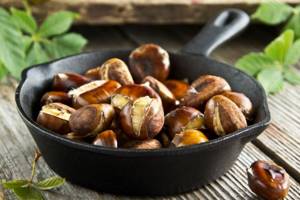
In addition to the above cooking methods, there are many other opportunities to make edible chestnuts a gastronomic decoration for your dishes. Chestnuts are added to flour, porridges, soups, and coffee and wine are made from them.
Here is a simple mono recipe for making baked chestnuts:
Preheat the oven to 200 degrees. Cut the chestnuts on the sharp side, place on a baking sheet, and place in the oven for 24 minutes. It is necessary to periodically check readiness. Chestnuts are baked when the skin begins to pull away from the kernels a little and the kernels themselves become soft.
How is edible chestnut different from horse chestnut?
Chestnut trees belong to the beech genus. Famous varieties include beeches and oaks. This is a small family that is classified according to different characteristics.
Horse chestnut belongs to the horse chestnut family. Edible chestnut and horse chestnut are similar only in name. Horse fruits are not eaten. They are suitable for pet food. The nuts of both representatives are externally similar. They are placed in pluses, which burst when ripe. Trees are distinguished by the structure of the leaves and the quality of flowering:
- horse chestnut blooms profusely, the inflorescences are collected in a kind of vertical candle;
- The edible inflorescences resemble elongated earrings.
What does chestnut look like and where does it grow?
Chestnut trees are representatives of the deciduous type that can grow up to 50 m in height; the bark of the slender trunk has a brown tint. The leaves are lanceolate-shaped and are recognized by small serrations along the edges. The nuts begin to ripen in October or early November, and after full ripening they fall off and crack.
The territories where chestnuts are most often found are the countries of Europe, Asia Minor, and the southern regions of Russia. Chestnuts can coexist with fir, beech or hornbeam.
Recipes for dishes made from edible chestnuts

This is a universal product. Nuts can be served as a side dish, added to desserts, ground into flour to flavor baked goods, and used as an ingredient to stuff meat.
Recipes with edible chestnuts:
- Pilaf
. Long grain rice, 500 g, wash until the water is clear, refill with cool water and leave for 2 hours. 0.5 kg of lamb is cut into portions and boiled until tender, skimming off the foam and adding salt. Dried apricots and raisins, together a little more than a glass, are poured with boiling water for 10 minutes. Chestnuts, about 100 g, peeled. The fruits are boiled in boiling water for 5-7 minutes. 2 medium-sized onions, finely chopped into strips and fried until golden brown in 80 g of butter. When the onion becomes beautiful, put the soaked dried fruits into the frying pan, squeezing out the water. After another 15 minutes, add the meat and simmer for another 15 minutes. The soaked rice is boiled until half cooked; overcooking is not recommended. Place it on a sieve to remove the liquid. Set aside 5 tablespoons of rice, mix with half or a third teaspoon of turmeric and a raw egg. This mixture is called gazmah. In another cup, mix 80 g of oil, another third teaspoon of turmeric, salt and melt in a water bath or in the microwave. The bottom of a thick-walled pan is greased with butter, a layer of gazmah is spread on the bottom, and then the rice is laid out in layers, layered with the remaining mixture of salt and turmeric. Push the chestnuts into the top layer with your finger so that they are completely embedded in the rice. Cover the pan with a waffle towel, then with a lid and simmer until the rice is ready. Meat and rice are combined in plates when serving. - Roasted chestnuts
. Preheat the oven along with the baking sheet to 220°C. The fruits are washed, and a cross-shaped cut is made on the side of the peak. Place on a baking sheet, smooth side down, and bake for about 20-30 minutes until the peel peels back into petals. The finished “nuts” are wrapped tightly in a clean waffle towel. After 5 minutes, when the roll is unrolled, the peel remains on it. Chestnuts can be served with salt or paprika. - Soup
. Transparent meat broth, 1 liter, is prepared in advance using water, meat and onions for cooking. Be sure to remove the foam. Chestnuts, 500 g, are peeled using the second method, pre-boiling. When the peel is completely removed, the fruits are cooked for another 3-4 minutes. Chestnuts are dipped into the broth, and while they are boiling, chop into strips (or grate on a coarse grater) 2 large carrots, 1 turnip and 1 onion. Fry vegetables in butter. When the vegetables are fried, remove the chestnuts from the pan and mash them into a puree, adding a teaspoon of sugar. Place the vegetables and nuts back into the pan and boil for another 3-4 minutes. Served with croutons. - Christmas dessert
. A little less than a bar of dark chocolate, 150 g, melt in a water bath, pour in cognac, 6 tablespoons, and half a teaspoon each of vanilla and coffee extract. Stir. Remove the container from the water bath and put 100 g of butter into it - it should melt on its own. Stir when the butter melts. Boil 500 g of peeled chestnuts until tender, puree them in a blender with half a glass of sugar, and mix with the butter-chocolate mixture. Using foil, shape the dough into a log. Leave to harden in the refrigerator. Overnight is usually enough for it to harden. In the morning, the foil is removed and the log is decorated. Prepare a water bath again, melt 50 g of butter, 150 g of chocolate, pouring a tablespoon of cognac. When you get a homogeneous consistency, decorate the log with patterns or cover it with an even layer of glaze. Place in the refrigerator for another 2-3 hours to allow the fudge to harden.
This is only a small part of the recommendations on how to prepare edible chestnuts. They can be fried, baked, boiled, steamed and grilled, experimented with by adding to various seasonings, and used as an edible decoration.
Not only dishes, but also drinks can be prepared from nuts. Let's look at the most popular of them:
- Kvass
. Place 40 pieces of cut fruit without peel into a three-liter container, fill it with water, add a glass of sugar and pour in a tablespoon of sour cream (can be replaced with half a glass of milk starter). Leave to ferment for 2 weeks at a temperature slightly above room temperature - 25-35°C. This drink not only quenches thirst, but also helps remove toxins and free radicals from the body. - Cocktail
. You should prepare for preparing the drink in advance. 200 g of chopped roasted chestnuts are poured into a bottle of cognac and left to infuse for 2 weeks. When the tincture is ready, you can start preparing the drink. Place in a shaker: 120 g of cognac liqueur, 45 ml of fresh lemon juice, 60 ml of red vermouth, add a handful of saffron. Everything is mixed. Place ice in a glass and then pour in the cocktail. You can reduce the amount of lemon juice and place the lemon slice directly into the glass.
Roasted nuts can be served as a snack with alcoholic drinks.
Treatment with chestnuts
Severe diarrhea (such as dysentery) can cause severe dehydration, which is a big problem. In alternative medicine, chestnut is often mentioned as an astringent. Researchers, after several observations, agreed: the tree bark and its nuts help stop diarrhea. The water in which the fruits (along with the shell) or bark were boiled is rich in tannins, which have medicinal properties. Natural medicine is prepared from 3 tablespoons of crushed bark or nuts and 1 liter of water (cook for 20 minutes). The decoction is taken 2-3 glasses per day. But it is worth noting that this folk remedy is not suitable for children, since tannins have a bad effect on unformed organisms.
Researchers confirm that chestnuts contain substances that act as expectorants on the body. This ability of the chestnut is actively used by pharmacists and herbalists, creating cough syrups with an extract of this plant.
And in India, chestnuts are used to remove helminths from the body.
How to cook roasted chestnuts
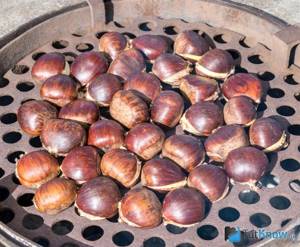
Of course, they do not sell it all year round, but during the ripening season, which varies depending on the region, for example, in Turkey they can be tasted as early as July, but in the Caucasus the fruits ripen only by the end of October. On the streets they are cooked on special frying pans. However, if you happen to have raw fruits in your hands and you need to cook roasted chestnuts at home yourself, an ordinary frying pan will do just fine.
The recipe is quite simple, but let's look at it step by step:
- Cut the dark brown shell crosswise on each side - if you don't do this, they will begin to "explode" during the heat treatment process.
- Place the chestnuts in the pan so that they do not turn out dry, cover them on top with a damp cotton cloth or napkin.
- Cover the pan with a lid and cook for 20-30 minutes, stirring occasionally and remembering to moisten the napkin with water if it is dry.
- A sign of readiness is the bursting shell.
Remove the finished nuts from the frying pan, peel the shells - and that’s it, you’re ready to eat.
How to eat roasted chestnuts? If you are trying fruits for the first time, we advise you to eat them without any additives to understand what they are like. Everyone describes the taste of roasted chestnuts very differently, some say that it is not very pronounced and is somewhat reminiscent of boiled potatoes, while others perceive distinct sweet and nutty notes.
Well, when you taste the chestnuts, you can choose additives to suit your taste, which can be very different, from salt and vegetable oil to chocolate glaze. In Europe they simply love nuts in sweet sauces!

